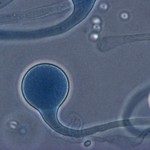Lien vers Pubmed [PMID] – 27535951
Clin. Infect. Dis. 2016 Nov; 63(10): 1312-1317
Invasive wound mucormycosis (IWM) is associated with an extremely poor outcome among critically ill burn patients. We describe the detection of circulating Mucorales DNA (cmDNA) for the early diagnosis of IWM in those patients and report the potential value of detecting cmDNA for treatment guidance. Severely ill burn patients admitted to our tertiary referral center between October 2013 and February 2016 were included. Retrospective plasma samples were tested for the presence of cmDNA by quantitative real-time polymerase chain reaction (qPCR). Patients were then prospectively screened twice a week, and liposomal amphotericin-B therapy initiated based on a positive qPCR. The primary endpoint was the time between cmDNA detection and standard diagnosis. Secondary endpoints were the time from cmDNA detection and treatment initiation and mortality. Seventy-seven patients (418 samples) were included. The average age was 46 (28-60) years, abbreviated burn severity index was 8 (7-10), and simplified acute physiology score was 33 (23-46). The total body surface area was 33% (22%-52%). cmDNA was detected 11 (4.5-15) days before standard diagnosis. The in-hospital mortality was 62% for patients with IWM and 24% for those without (P = .03). The mortality due to IWM was 80% during period A and 33% during period B (P = .46). This study suggests that the detection of cmDNA allows earlier diagnosis of IWM in severely ill burn patients and earlier initiation of treatment. Further studies are needed to confirm the impact of earlier treatment initiation on patient outcome.




